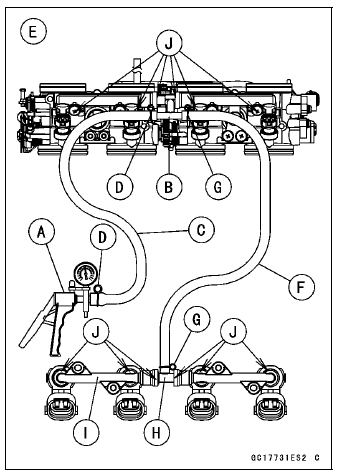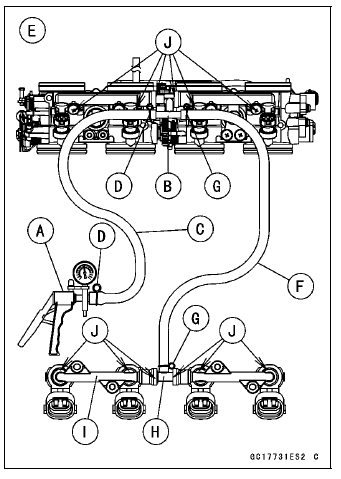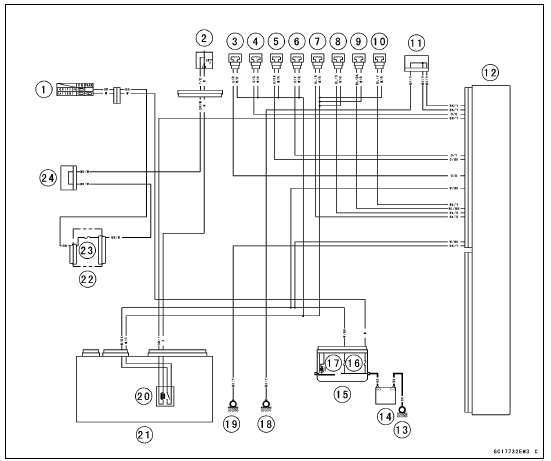


Do not remove the nozzle assy from the air cleaner housing.
Be sure to place a piece of cloth around the fuel outlet pipe of the fuel pump and the delivery pipe of the throttle body assy.
| WARNING Fuel is flammable and explosive under certain conditions and can cause severe burns. Be prepared for fuel spillage; any spilled fuel must be completely wiped up immediately. When the fuel hose is disconnected, fuel spills out from the hose and the pipe because of residual pressure. Cover the hose connection with a piece of clean cloth to prevent fuel spillage. |
Connect a commercially available vacuum/pressure pump [A] to the nipple of the delivery pipe [B] with the fuel hose [C] (both ends with the clamps [D]) as shown in the figure.
Rear View [E]

Apply soap and water solution to the areas [J] as shown in the figure.
Watching the pressure gauge, squeeze the pump lever, and build up the pressure until the pressure reaches the maximum pressure.
Injector Fuel Line Maximum Pressure Standard: 300 kPa (3.06 kgf/cm², 43 psi)
NOTICE
During pressure testing, do not exceed the maximum pressure for which the system is designed.
Watch the gauge for at least 6 seconds.
If the pressure holds steady, the fuel line is good.
If the pressure drops at once or if bubbles are found in the area, the fuel line is leaking. Replace the delivery pipe assy, injectors and related parts.
Install: Primary and Secondary Fuel Hoses (see Fuel Hose Replacement in the Periodic Maintenance chapter) Air Cleaner Housing (see Air Cleaner Housing Removal) Fuel Tank (see Fuel Tank Removal)
Start the engine and check for fuel leakage.
Fuel Injector Circuit

1. Ignition Switch
2. Engine Stop Switch
3. Secondary Fuel Injector #1
4. Secondary Fuel Injector #2
5. Secondary Fuel Injector #3
6. Secondary Fuel Injector #4
7. Primary Fuel Injector #1
8. Primary Fuel Injector #2
9. Primary Fuel Injector #3
10. Primary Fuel Injector #4
11. Joint Connector E
12. ECU
13. Engine Ground
14. Battery
15. Starter Relay
16. Main Fuse 30 A
17. ECU Fuse 15 A
18. Frame Ground 2
19. Frame Ground 1
20. Fuel Pump Relay
21. Relay Box
22. Fuse Box 1
23. Ignition Fuse 15 A
24. Joint Connector F
 Fuel Injector Output Voltage Inspection
Fuel Injector Output Voltage Inspection Throttle Grip and Cables
Throttle Grip and CablesValve Clearance Inspection
NOTE
Valve clearance must be checked and adjusted when
the engine is cold (at room temperature).
Remove:
Crankshaft Sensor Cover (see Crankshaft Sensor Removal
in the Electrical System chapter)
Cylinder Head Cover (see Cylinder Head Cover Removal
in the Engine Top End chapter)
Turn t ...
Multifunction Display
The multifunction display indicates
the following modes.
Odometer
Trip meter A
Trip meter B
Current Mileage
Average Mileage
Fuel Consumption
Stop Watch
These display modes can be shifted
by pushing the upper button.
NOTE
The “FUEL” warning can be indicated
if the ...
DFI System Troubleshooting Guide
NOTE
This is not an exhaustive list, giving every possible cause for each
problem listed. It is meant
simply as a rough guide to assist the troubleshooting for some of the more
common difficulties in
DFI system.
The ECU may be involved in the DFI electrical and ignition system
tro ...